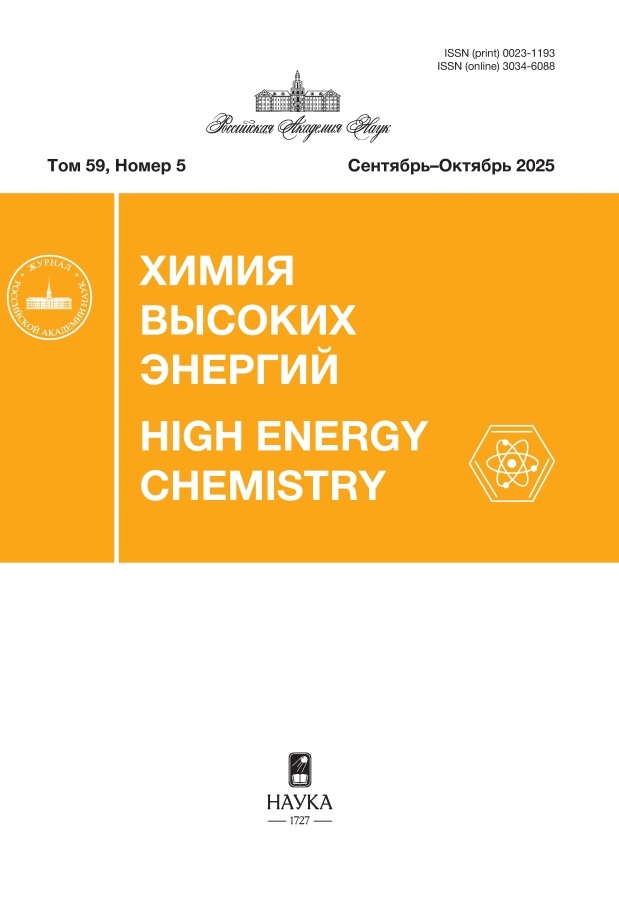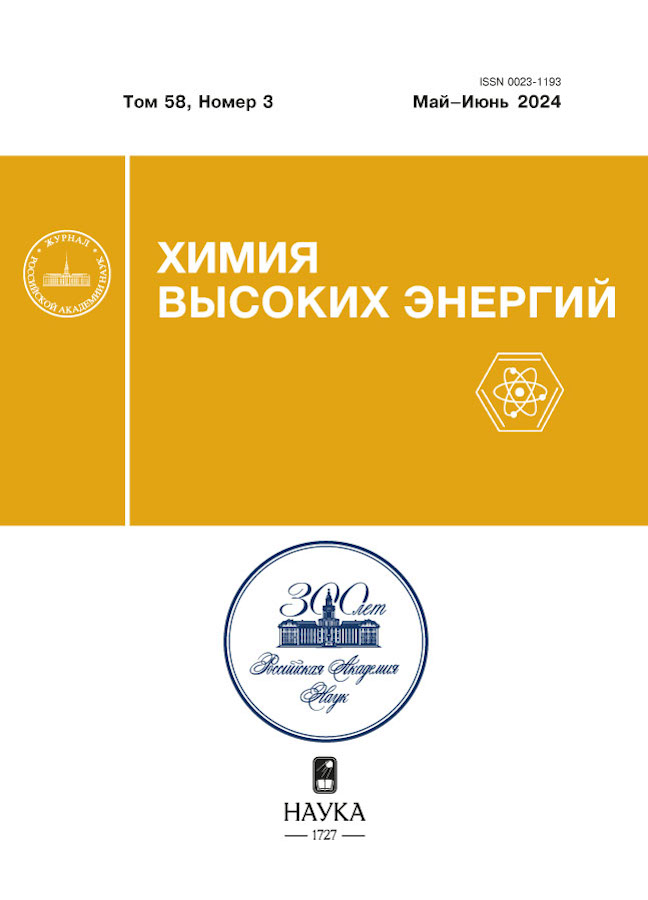Моделирование образования ацетилена из метана в плазменной струе
- Авторы: Билера И.В.1, Лебедев Ю.А.1, Титов А.Ю.1, Эпштейн И.Л.1
-
Учреждения:
- Институт нефтехимического синтеза им. А.В. Топчиева Российской академии наук
- Выпуск: Том 58, № 3 (2024)
- Страницы: 221-232
- Раздел: ПЛАЗМОХИМИЯ
- URL: https://kld-journal.fedlab.ru/0023-1193/article/view/661348
- DOI: https://doi.org/10.31857/S0023119324030071
- EDN: https://elibrary.ru/UUBYAY
- ID: 661348
Цитировать
Полный текст
Аннотация
Настоящая работа посвящена численному моделированию реакции конверсии метана в ацетилен в условиях плазмоструйного пиролиза и сравнению полученных результатов с имеющимися экспериментальными данными. Расчеты проводились в рамках модели реактора идеального вытеснения для атмосферного давления. Проведен анализ основных процессов разложения метана и образования ацетилена в случаях, когда в качестве плазмообразующего газа использовался либо водород, либо метан. Результаты расчетов основных продуктов разложения метана (водорода и ацетилена) хорошо согласуются с экспериментальными данными.
Ключевые слова
Полный текст
Об авторах
И. В. Билера
Институт нефтехимического синтеза им. А.В. Топчиева Российской академии наук
Email: lebedev@ips.ac.ru
Россия, Москва
Ю. А. Лебедев
Институт нефтехимического синтеза им. А.В. Топчиева Российской академии наук
Автор, ответственный за переписку.
Email: lebedev@ips.ac.ru
Россия, Москва
А. Ю. Титов
Институт нефтехимического синтеза им. А.В. Топчиева Российской академии наук
Email: lebedev@ips.ac.ru
Россия, Москва
И. Л. Эпштейн
Институт нефтехимического синтеза им. А.В. Топчиева Российской академии наук
Email: lebedev@ips.ac.ru
Россия, Москва
Список литературы
- Антонов В.Н., Лапидус А.С. Производство ацетилена. М.: Химия, 1970. 416 с.
- Темкин О.Н., Шестаков Г.К., Трегер Ю.А. Ацетилен: Химия. Механизмы реакций. Технология. М.: Химия, 1991. 416 с.
- Pässler P., Hefner W., Buckl K. et al. Acetylene. In Ullmann’s Encyclopedia of Industrial Chemistry, 7th ed.; Wiley-VCH Verlag GmbH & Co: Weinheim, Germany, 2008. https://doi.org/10.1002/14356007.a01 097.pub3
- Shlyapin D.A., Afonasenko T.N., Glyzdova D.V. et al. // Catalysis in Industry. 2022. V. 14. № 3. P. 251.
- Bedenko S.P., Dement’ev K.I., Maximov A.L. // Petroleum Chemistry. 2022. V. 62. № 9. P. 989.
- Arutyunov V.S., Savchenko V.I., Sedov I.V., Nikitin A.V. // Catalysis in Industry. 2022. V. 14. № 1. P. 1.
- Maretina I.A. // Russ. J. Appl. Chem. 1996. V. 69. № 3. P. 311.
- Maretina I.A., Trofimow B.A. // Russ. Chem. Rev. 2000. V. 69. № 7. P. 591.
- Slovetskii D.I., Mankelevich Yu.A., Slovetskii S.D., Rakhimova T.V. // High Energy Chemistry. 2002. V. 36. № 1. P. 44.
- Кинетика и термодинамика химических реакций в низкотемпературной плазме. Под ред. Л.С. Полака. М.: Наука, 1965. 255 с.
- Bilera I.V., Lebedev Y.A. // Petroleum chemistry. 2022. V. 62. № 4. P. 329.
- Dors M., Nowakowska H., Jasinski M., Mizeraczyk J. // Plasma Chem. Plasma Process. 2014. V. 34. № 2. P. 313.
- Hughes K.J., Turanyi T., Clague A.R., Pilling M.J. // Int. J. Chem. Kinet. 2001. V. 33. № 9. P. 513.
- Cheng Y., Li T., Rehmet C., An H. et al. // Chemical Engineering J. 2017. V. 315. P. 324.
- An H., Cheng Y., Li T., Cheng Y. // Fuel Processing Technology. 2018. V. 172. P. 195.
- Wang H., You X., Joshi A.V. et al., USC Mech Version II. High-Temperature Combustion Reaction Model of H2/CO/C1-C4 Compounds. http://ignis.usc.edu/USC_Mech_II.htm, May 2007.
- Appel J., Bockhorn H., Frenklach M. // Combustion and Flame. 2000. V. 121. P. 122.
- Ma J., Su B., Wen G., Ren Q. et al. // Int. J. Hydrogen Energy. 2016. V. 41. № 48. P. 22689.
- Marinov N.M., Pitz W.J., Westbrook C.K. et al. // Combustion and Flame. 1998. V. 114. № 1–2. P. 192–213.
- Holmen A., Rokstad O.A., Solbakken A. // Ind. Eng. Chem. Process Des. Dev. 1976. V. 15. № 3. P. 439.
- Zhang H., Wang W., Li X. et al. // Chemical Engineering J. 2018. V. 345. P. 67.
- Heijkers S., Aghaei M., Bogaerts A. // J. Physical Chemistry C. 2020. V. 124. № 13. P. 7016.
- Ravasio S., Cavallotti C. // Chem. Eng. Sci. 2012. V. 84. P. 580.
- Agafonov G.L., Smirnov V.N., Vlasov P.A. // Proc. Combust. Inst. 2011. V. 33. № 1. P. 625.
- Shao C., Kukkadapu G., Wagnon S.W. et al. // Comb. Flame. 2020. V. 219. P. 312.
- Kozlov G.I., Khudyakov G.N., Kobzev Yu.N. // Petroleum Chemistry U.S.S.R. 1967. V. 7. № 1. P. 83.
- Кобзев Ю.Н., Козлов Г.И., Худяков Г.Н. // Химия высоких энергий. 1970. Т. 4. № 6. С. 519.
- Epstein I.L., Lebedev Yu.A., Tatarinov A.V. Bilera I.V. // J. Phys. D: Appl. Phys. 2018. V. 51. 214007.
- GRI-Mech 3.0. http://combustion.berkeley.edu/gri-mech/
- Wang H., Frenklach M. // Comb. Flame. 1997. V. 110. P. 173
- Mehl M., Pitz W.J., Westbrook C.K., Curran H.J. // Proc. Combust. Inst. 2011. V. 33. P. 193.
- Curran H.J., Gaffuri P., Pitz W.J., Westbrook C.K. // Comb. Flame. 1998. V. 114. № 1–2. P. 149.
- Merkulov A.A., Ovsyannikov A.A., Polak L.S. et al. // Plasma Chem. Plasma Process. 1989. V. 9. № 1. P. 95.
- Merkulov A.A., Ovsyannikov A.A., Polak L.S., Popov V.T., Pustilnikov V.Yu. // Plasma Chem. Plasma Process. 1989. V. 9. № 1. P. 105.
- Эмануэль Н.М., Кнорре Д.Г. Курс химической кинетики. М.: Высшая школа, 1974. 399 с.
- Франк-Каменецкий Д.А. Диффузия и теплопередача в химической кинетике. М.: Наука, 1987.
- Lebedev Yu.A., Tatarinov A.V., Epstein I.L. // Plasma Chem. Plasma Processing. 2019. V. 39. № 4. P. 787, https://doi.org/10.1007/s11090-019-09975-8
- Frenklach M., Wang H. // Proc. Comb. Inst. 1991.V. 23. P. 1559.
- Shterenberg A.M. // Vestnik Samarsk. Univer. Phys.-Math. Ser. 1998. P. 55 (in Russian).
- Winters H. // J. Chem. Phys. 1975. V. 63. P. 3462.
- Cacciatore M., Capitelli M., Dilonardo M. // Chem. Phys. 1978. V. 34. P. 193.
- Morgan Database (2014). www.lxcat.net. Retrieved 29 Aug 2014.
- Janev R., Reiter D. // Phys. Plasmas. 2004. V. 11. P. 780–829.
- Starikovsky A., Aleksandrov N. // Progr. Energy Combust. Science. 2013. V. 39. P. 61.
- Wang W., Snoeckx R., Zhang X. et al. // J. Physical Chemistry C. 2018. V. 122. № 16. P. 8704.
- Овсянников А.А. Химические реакции в турбулентных потоках низкотемпературной плазмы в сб. Низкотемпературная плазма 3. Под ред. Л.С. Полака и Ю.А. Лебедева, Новосибирск: Наука, 1981.
Дополнительные файлы


















